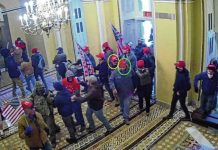With two weeks to go until the end of an experimental project at 17th Street, city officials expect to soon see data regarding its impact on traffic conditions.
Senior Planner Emilie Pinkston said that the city should receive data this week on motor vehicle speeds and volumes from counters at the site and take some time to analyze the results.
The traffic calming project was installed two weeks ago and will last through Oct. 1, according to the City of Columbus — Bartholomew County Planning Department. It is a partnership between the city and Columbus Regional Health Healthy Communities.
The temporary project includes a traffic diverter at the 17th and Washington intersection; a traffic circle and four-way stop at the 17th and Franklin intersection; a four-way stop at the 17th and Lafayette intersection; and painted crosswalks at the entrance of Donner Park. Pinkston said that the crosswalks are on the north side of 17th and Lafayette.
These elements are intended to slow vehicular traffic and improve conditions for bicyclists and pedestrians.
The project provides a chance for the city to “test the impact of the traffic calming design elements and collect further public feedback before making final design decisions for the street,” planning officials said.
The temporary features were installed the morning of Aug. 30, said City Engineer Dave Hayward. Some adjustments were made later, at the request of the Columbus Fire Department.
“I don’t think we’ve had any trouble with anybody having any accidents from them since then,” he said. “We’ve also tried DPW (Department of Public Works) trucks to make sure they can get through.”
The site’s safety features include warning signs for stops and, in some cases, LED lights on stop signs in areas with impaired visibility.
The city engineer said, half-jokingly, that he’s pleased that no one has run over the project elements yet.
Hayward hasn’t seen any confusion from the changes, and he drives through the area on a daily basis to “keep an eye on it.” He also lives in a nearby neighborhood.
It’s hard to tell, at this point, if the elements are slowing down traffic, Hayward said, but it’s likely that motorists are still driving somewhat faster than what some nearby residents would prefer.
Vehicle counters at the site should shed some light on this, Pinkston said. There is also a bicycle counter as well.
“They’re a plate that, when traffic drives over, we can count cars and we can tell how fast they’re going,” Hayward said. “And bicycle counters are basically the old-fashioned tube-type counters that count every bicycle that goes across it.”
The counters can differentiate between cars and bicycles, as well as what direction they’re traveling.
“The counters are placed at various locations on 17th, Franklin and Lafayette so we can see … how far the traffic calming impacts the speed changes,” Pinkston added.
In addition to gathering data on the project’s impact, the city is also seeking feedback from residents.
Pinkston said that the city is collecting online survey responses from the community through the end of the month.
“We’re not looking for the most popular options,” Hayward said. “We’re looking for what works. So it doesn’t help us if people call and say, ‘I don’t like it.’ But if they call and say, ‘I don’t like it because…,’ that might help us. So that’s what we’re really looking for, is some good solid reasoning, some things that we may not see in traffic counts or speed data that they see if they live close by.”
So far, some neighbors “really like” the project and have mentioned benefits, while others have pointed out disadvantages, said Pinkston, but didn’t elaborate on what were the drawbacks.
“So we don’t impact how people feel about the project, we’d like to just wait and see what the public thinks at the end of the month and then review all of that data together — just so we don’t influence how new users might feel about the project,” she said.
When asked if the city might consider doing other temporary projects in the future, Hayward said it’s possible, but such projects present certain challenges.
“It’s very tricky to do something temporarily with traffic, so we want to be very careful with that,” he said. “That’s why we’re trying to learn as much with this opportunity as we can, so that we don’t have to do temporary things at other locations if we can avoid it.”
However, he did note that the project allows the city to try out traffic diverters and get more experience with traffic circles.
Pinkston said the temporary project gives the city a “hands-on experience” with traffic calming measures commonly used on bicycle boulevards, which city officials have described as streets with “low motorized traffic volumes and speeds designed to give bicycle travel the priority.”
“Being able to really see how they (the measures) impact traffic patterns and traffic speeds before making a final design decision is just really helpful for us,” she said.





